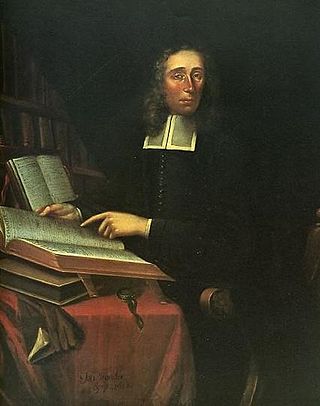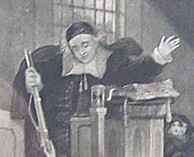
Hadley is a town in Hampshire County, Massachusetts, United States. The population was 5,325 at the 2020 census. It is part of the Springfield, Massachusetts Metropolitan Statistical Area. The area around the Hampshire and Mountain Farms Malls along Route 9 is a major shopping destination for the surrounding communities.
Edward Whalley was an English military leader during the English Civil War and was one of the regicides who signed the death warrant of King Charles I of England.

William Goffe, c. 1613/1618 - 1679/1680, was an English soldier from London who fought for Parliament during the Wars of the Three Kingdoms. A religious radical nicknamed “Praying William” by contemporaries, he approved the Execution of Charles I in January 1649, but escaped prosecution as a regicide by fleeing to New England.

Increase Mather was a New England Puritan clergyman in the Massachusetts Bay Colony and president of Harvard College for twenty years (1681–1701). He was influential in the administration of the colony during a time that coincided with the notorious Salem witch trials.

King Philip's War was an armed conflict in 1675–1676 between a group of indigenous peoples of the Northeastern Woodlands against the English New England Colonies and their indigenous allies. The war is named for Metacom, the Pokanoket chief and sachem of the Wampanoag who adopted the English name Philip because of the friendly relations between his father Massasoit and the Plymouth Colony. The war continued in the most northern reaches of New England until the signing of the Treaty of Casco Bay on April 12, 1678.

John Dixwell, alias James Davids, was an English lawyer, republican politician and regicide. Born in Warwickshire, during the Wars of the Three Kingdoms he held various administrative positions in Kent on behalf of Parliament, and approved the Execution of Charles I in January 1649. Under the Commonwealth, he served as Governor of Dover Castle, and was a member of the English Council of State.

Richard Mather was a New England Puritan minister in colonial Boston. He was father to Increase Mather and grandfather to Cotton Mather, both celebrated Boston theologians.
John Sassamon, also known as Wussausmon, was a Massachusett man who lived in New England during the colonial era. He converted to Christianity and became a praying Indian, helping to serve as an interpreter to New England colonists. In January 1675, Sassamon was ambushed and assassinated. A mixed jury of colonists and Indian elders convicted and executed three Wampanoag men for his murder. These events helped spark the conflict known as King Philip's War, in which the New England Colonies defeated the Wampanoag and ended armed resistance by the Native Americans of southeastern New England.

John Russell was a Puritan minister in Hadley, Massachusetts, during King Philip's War. As such, he is part of the Angel of Hadley legend.

The Great Swamp Massacre or the Great Swamp Fight was a crucial battle fought during King Philip's War between the colonial militia of New England and the Narragansett people in December 1675. It was fought near the villages of Kingston and West Kingston in the Colony of Rhode Island and Providence Plantations. The combined force of the New England militia included 150 Pequots, and they inflicted a huge number of Narragansett casualties, including many hundreds of women and children. The battle has been described by historians as "one of the most brutal and lopsided military encounters in all of New England's history."
William Leete was Governor of the Colony of New Haven from 1661 to 1665 and Governor of the Colony of Connecticut from 1676 to 1683.

Danyell "Daniel" Gookin was a Munster colonist, settler of Virginia and Massachusetts, and a writer on the subject of American Indians.

The Battle of Bloody Brook was fought on September 28, 1675 between an indigenous war party primarily composed of Pocumtuc warriors and other local indigenous people from the central Connecticut River valley, and the English colonial militia of the New England Confederation and their Mohegan allies during King Philip's War.
The siege of Springfield was a siege of the colonial New England settlement of Springfield in 1675 by Native Americans during King Philip's War. Springfield was the second colonial settlement in New England to be burned to the ground during the war, following Providence Plantations. King Philip's War remains, per capita, the bloodiest war in American history.
"The Gray Champion" is a short story published in 1835 by the American writer Nathaniel Hawthorne
John Strong (1610–1699) was an English-born New England colonist, politician, Puritan church leader, tanner, and one of the founders of Windsor, Connecticut, and Northampton, Massachusetts, as well as the progenitor of nearly all the Strong families in what is now the United States. He was referred to as Elder John Strong because he was an Elder in the church.

William Jones was an English lawyer who emigrated to the United Colonies of New England and became the twenty-fourth Deputy Governor of the Colony of Connecticut. He notably hosted at his home the regicides Whalley and Goffe, family members of Oliver Cromwell.
The phrase "Goffe and Whalley" or "Whalley and Goffe" refers to two men who fled in 1660 to Massachusetts Bay Colony and ultimately New Haven after their involvement in the 1649 regicide of King Charles I of England:
Peter Jethro was an early Native American (Nipmuc) scribe, translator, minister, land proprietor, and Praying Indian affiliated for a period with John Eliot in the praying town of Natick, Massachusetts.
Rev. Hope Atherton (1646–1677) was a colonial clergyman. He was born in Dorchester, Massachusetts. Harvard Class of 1665. He was the minister of Hadley, Massachusetts. He served as a chaplain in the King Philips War and became separated from troops during the Battle of Great Falls in 1676. He died months after the battle, aged 30.











